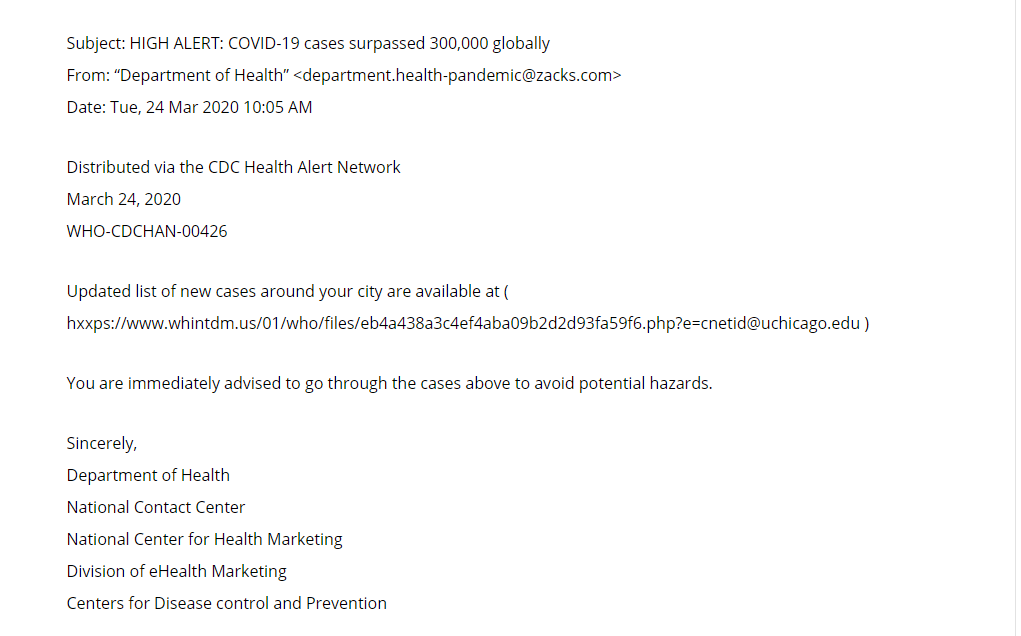The amount of misleading information regarding the current COVID-19 pandemic is absolutely overwhelming. It is used to trick and take advantage of people in their vulnerable state, so it is imperative to stay clear of unreliable sources online. Unfortunately, scammers are well aware of scare tactics and they certainly use the current crisis to their advantage. In addition to the already existing Corona virus-related scams like “Corona Virus Face Mask” email virus, “COVID-19 Solution Announced by WHO” scam, CoronaVi2022 Ransomware, and, sadly, many more, comes a new invention called COVID-19 Cases Surpassed 300,000 Email Scam.
Text presented in the “COVID-19 Cases Surpassed 300,000 Email Scam” email letter:
Subject: HIGH ALERT: COVID-19 cases surpassed 300,000 globally
Distributed via the CDC Health Alert Network
March 24, 2020
WHO-CDCHAN-00426Update list of new cases around your city are available at ( hxxps://www.cdc.gov/coronavirus/2019-ncov/locations-confirmed-cases.html )
You are immediately advised to go through the cases above to avoid potential hazards.
Sincerely,
Department of Health
National Contact Center
National Center for Health Marketing
Division of eHealth Marketing
Centers for Disease control Prevention
The fake COVID-19 Cases Surpassed 300,000 email claims to come from the Centers for Disease Control and Prevention organization and share information regarding Corona virus. Its subject reads “HIGH ALERT: COVID-19 cases surpassed 300,000 globally”, while the body of the email contains a link to an updated list of new cases of the virus around the world, which the recipient is urged to look through. The aim of this fictitious email is to trick users into clicking on the provided link that opens a fake Microsoft Outlook login page.
The fake Outlook page is used by cyber crooks to gather users’ login details. By collecting this information, the hackers could gain access to not only Outlook, but other accounts as well. They can use the stolen accounts to distribute other scams, send out malign attachments and links to everyone in the contact list, access private information, and so on. If you are aware of these scams, you can make sure that you never click on any suspicious links, download any unreliable attachments, or enter your login details on untrustworthy pages.
As we have already mentioned, this scam is not the only one of its kind and as long as COVID-19 stays a hot topic, it is likely that cyber criminals will continue using it in their scams. These scams could also be aimed at stealing your personal information or at infecting your device with harmful files and programs that could encrypt your data and damage your system. You should be aware of other malware distribution methods as well, because fake emails are certainly not the only technique that hackers use. It is possible to infect computers with Trojans, viruses, or other threats by downloading software or media files from unofficial third-party websites, P2P networks, Torrents, and so on. Every time you download something from such pages, you risk infecting your PC. The same can be stated about third-party software hosting domains that present users with various cracking tools. In addition to that, you should also be aware of freeware and shareware bundles that distribute potentially unwanted applications like browser hijackers and adware.
If you have fallen for COVID-19 Cases Surpassed 300,000 Email Scam or any other phishing tactic, it is important that you make sure that your device is clean. The first thing you have to do is scan your system with an anti-malware utility to see if there are any malign elements on it. You are welcome to implement the security tool from our page. The malware remover will scan your device and eliminate all found threats. Once your device is infection-free, you can move on to changing or resetting your passwords on your email and other online accounts. You should also check your settings as hackers may have made some modifications to them. Finally, make sure to stay up-to-date with the latest tricks used by cyber criminals, so that you do not have to deal with other scams in the future.
